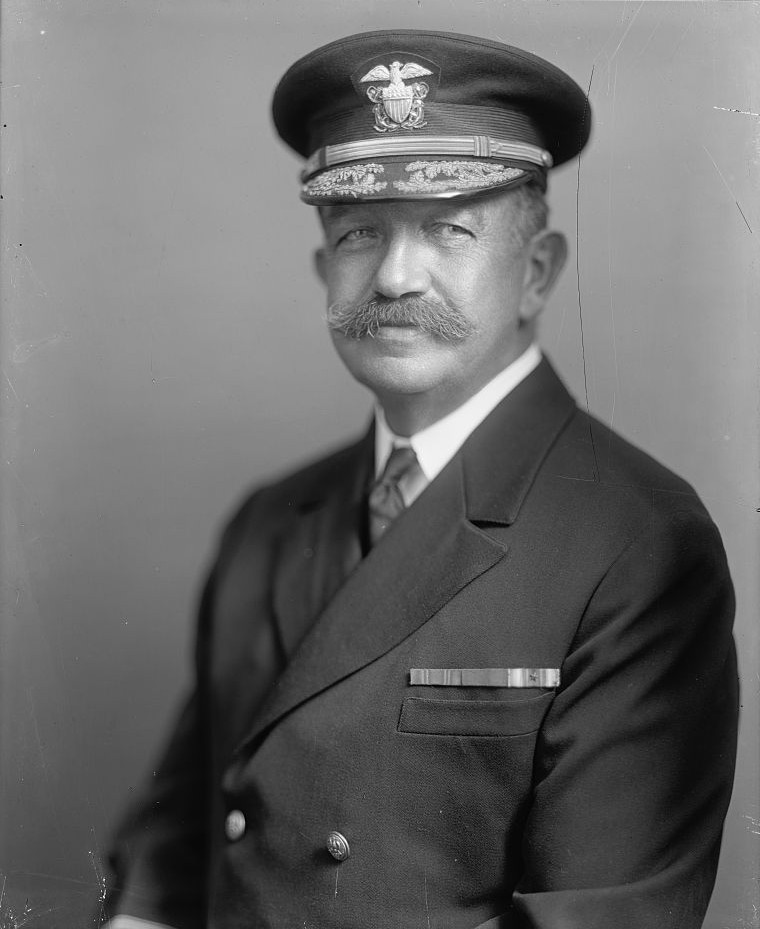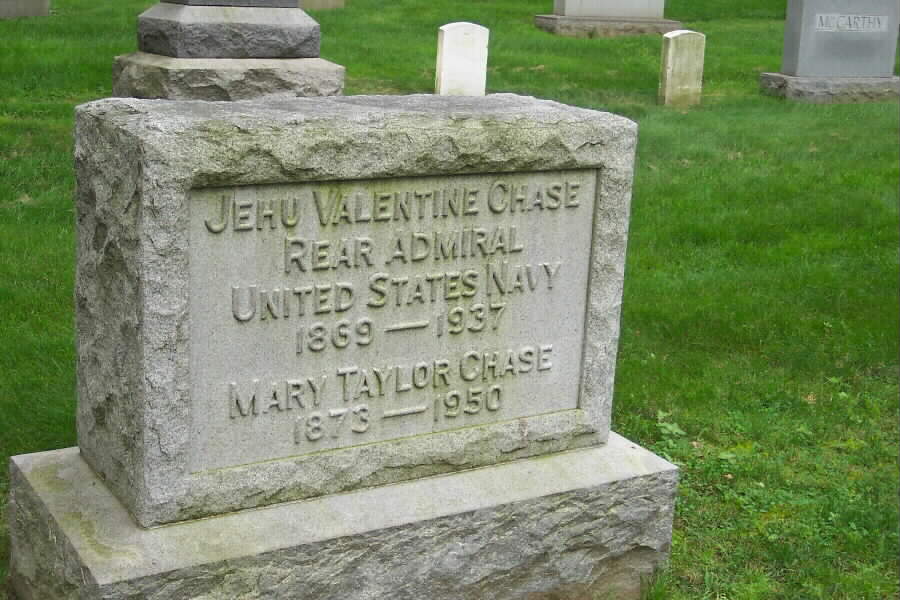Jehu Valentine Chase was born in Pattersonville, Louisiana, 10 January 1869, and graduated from the Naval Academy 6 June 1890.
As commanding officer of USS Minnesota when she was mined in September 1918, Chase was awarded the Distinguished Service Medal in recognition of his splendid seamanship and leadership in bringing his ship safely to port without loss of life.
Admiral Chase was Commander in Chief, United States Fleet, from 17 September 1930 to 15 September 1931, and Chairman of the General Board from April 1932 until his retirement in February 1933.
He died at Coronado, Calif., 24 May 1937. Chase (DE-158) was named in his honor.
Admiral Chase was buried with full military honors in Section 1 of Arlington National Cemetery. His wife, Mary Taylor Chase (1873-1950) is buried with him.
His grandson, James Franklin Caldwell, Captain, United States Navy, is also buried in Arlington National Cemetery.
His father-in-law, Henry Clay Taylor, Rear Admiral, United States Navy, is also buried in Arlington National Cemetery.
ADMIRAL J. V. CHASE DIES IN CALIFORNIA
Former Commander-in-Chief of United States Was 46 Years in the Navy
Had Served in Two Wars
Honored for his Work in Saving his Battleship, the Minnesota, Hit by Mine in 1918
CORONADO, California, May 25, 1937 – Rear Admiral Jehu V. Chase, former commander of the United States Fleet, died yesterday in a Coronado hospital at the age of 68.
A veteran of the Spanish-American War and World Wars, Admiral Chase has a long and exceptionally distinguished career in the United States Navy. He was for a year a full Rear Admiral while he served a Commander-in-Chief of the United States Fleet and his last post was chairman of the Navy’s General Board.
He served more than forty-six years in the Navy, until February 1, 1933, when he retired as a Rear Admiral, a rank to which he had reverted after heading the fleet. His career included long cruises, great danger and expert testimony before Congressional committees. He was a gunnery and ordnance expert.
On September 29, 1918, the battleship, with him in command, struck a mine, presumably laid by a German submarine, off the Delaware Breakwater. Under his command, the warship reached port without the loss of life. For his World War services he received the Distinguished Service Medal. The citation follows:
“For exceptionally meritorious service in a duty of great responsibility as commanding officer of the USS Minnesota and also for the splendid seamanship shown in bringing the Minnesota safely into port after being mined, with a hole in here underwater body approximately thirty feet long and extending afterward ships from port side of keel to starboard armor shelf and protective deck, without loss of life.”
Born in Pattersonville, Louisiana, Admiral Chase entered the Untied States Naval Academy at Annapolis, Maryland, in September 1885, and was graduated in 1890. He was commissioned Ensign in 1892, promoted to Lieutenant in 1899, Lieutenant Commander in 1905, Commander in 1911, Captain in 1916, Rear Admiral in 1922. He was Commander-in-Chief of the United States Fleet from September 17, 1930 to September 15, 1931.
He served on the USS Newport when the United States was at war with Spain in 1898. From 1902 to 1905 he commanded the USS Whipple and from 1905 to 1907 he was commander of the Naval Torpedo Station at Newport, Rhode Island.
He became navigator of the USS Kearsarge in 1907 and was with the fleet that went around the work when President Theodore Roosevelt demonstrated the strength of the Navy in that year.
Admiral Chase became flag secretary for the commander of the Third Squadron, Pacific Fleet, in 1910 and later that year commander of the USS Tallahassee. He served as inspector of ordnance at the Whitehead Torpedo Works, Weymouth, England, in 1911-12 and commanded the USS Monterey in 1912-13 and the USS Cincinnati in 1913-14.
From 1914 to 1917 Admiral Chase was a member of the special board of ordnance. While the United States was a war with Germany he commanded the USS Minnesota.
After the peace he served with the Bureau of Ordnance and later that year assumed command of the Base Force, Pacific Fleet. In 1924 he became commandant to the Thirteenth Naval District and from 1926 to 1928 he was in command of Battleship Division Four, Battle Fleet. He was on duty with the General Board of the Navy from 1928 to 1930.
In 1931, after relinquishing the fleet command, the Admiral joined the General Board, becoming its Chairman in April 1932, and continuing in that post until his retirement.
In 1921, the United States Naval Institute, composes of navy officers stationed throughout the world, awarded it annual gold medal and $200 for the best essay on a naval subject to Admiral Chase. His subject was “Accuracy on Fire at Long Ranges.”
In 1930 he told the Senate Committee on Foreign Relations that the London Naval Treaty left the United States in an inferior position, holding that parity would not be achieved under the treaty in all classes of ships with Great Britain of Japan.
CHASE, JEHU VALENTINE
- REAR ADMIRAL US NAVY RETIRED
- VETERAN SERVICE DATES: Unknown
- DATE OF DEATH: 05/24/1937
- DATE OF INTERMENT: 06/04/1937
- BURIED AT: SECTION WEST SITE 601
ARLINGTON NATIONAL CEMETERY
CHASE, MARY TAYLOR WIDOW OF JEHU VALENTINE
- DATE OF DEATH: 09/06/1950
- DATE OF INTERMENT: 09/11/1950
- BURIED AT: SECTION 1 SITE 601 WH
- ARLINGTON NATIONAL CEMETERY
WIFE OF JV CHASE – R/ADM USN
Michael Robert Patterson was born in Arlington and is the son of a former officer of the US Army. So it was no wonder that sooner or later his interests drew him to American history and especially to American military history. Many of his articles can be found on renowned portals like the New York Times, Washingtonpost or Wikipedia.
Reviewed by: Michael Howard


